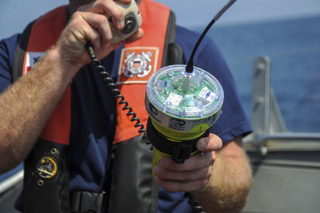Coast Guard Urges EPRIB Registration, Float Plans
 |
SEATTLE – Every year the Coast Guard makes thousands of phone calls to mariners, boat owners and emergency points of contact in response to receiving distress alerts from emergency position indicating radio beacons.
An EPIRB is a beacon that alerts the Coast Guard that the vessel registered to the EPIRB is in distress and requires a search and rescue response. These alerts can often mean the difference between the life and death of persons on the water and have been critical to providing rescue teams with the necessary information to quickly and effectively respond.
How does an EPIRB work? These devices can be activated either manually or automatically when submerged in water. Once activated, the device will release a signal that is picked up by a satellite and transferred to the nearest receiving Land User Terminal. The land terminal forwards the signal to the United States Mission Control Center, which then passes the information to the applicable Coast Guard District for response action. Once received, the Coast Guard activates the Search and Rescue system and uses the beacon registration information and the position provided from the satellite to coordinate response. One of the most effective means to locate the vessels and persons in distress is by calling individuals associated with the beacon’s registration – which may be you!
If you are receiving a call from the Coast Guard about an EPIRB alert, it is likely that you are listed as a point of contact or emergency point of contact on the beacon registration. When receiving this call, it is important to note that the vessel may or may not be in distress, but more information is needed to verify. Some alerts are released in error; however, the Coast Guard responds to each alert as an actual distress until it can be confirmed otherwise.
In some cases, a position is not obtained by the satellite, leaving search and rescue authorities with only the beacon’s registration information to determine a vessel’s location and distress situation. Out of date, or improperly registered beacons, can make locating the vessel in distress difficult and impede the response time of search and rescue teams. It is of critical importance that owners update beacon registration when acquiring a new vessel, when point of contact information changes, or, at a minimum, every two years as required by the National Oceanic and Atmospheric Administration. In addition to having an up to date EPIRB, it is always best practice to leave a float plan detailing your voyage intentions, whether short or long, with a friend or emergency contact.
“While we don’t keep float plans for you, we do recommend that you keep your loved ones informed, especially if they are a part of your EPIRB registration,” said Scott Giard, Search and Rescue Program Manager for the 13th Coast Guard District. “If your family can confirm that you are underway and can provide a general location, it helps our crews get to you that much faster if you are in actual distress.”
The Coast Guard has a boating safety app available at https://uscgboating.org/mobile/, which features a virtual float plan that
can be emailed to anyone the boater chooses.
For more information about EPIRBs and registration questions, please visit NOAA’s Search and Rescue Satellite Aided Tracking website at https://www.sarsat.noaa.gov/faq%202.html. To register your EPIRB, visit https://www.beaconregistration.noaa.gov and select Register Your Beacon. There, you can update your beacon registration, report if it is lost or stolen, learn to properly dispose your old beacons and batteries, correctly test you 406 MHz beacon, and more.
-USCG-
